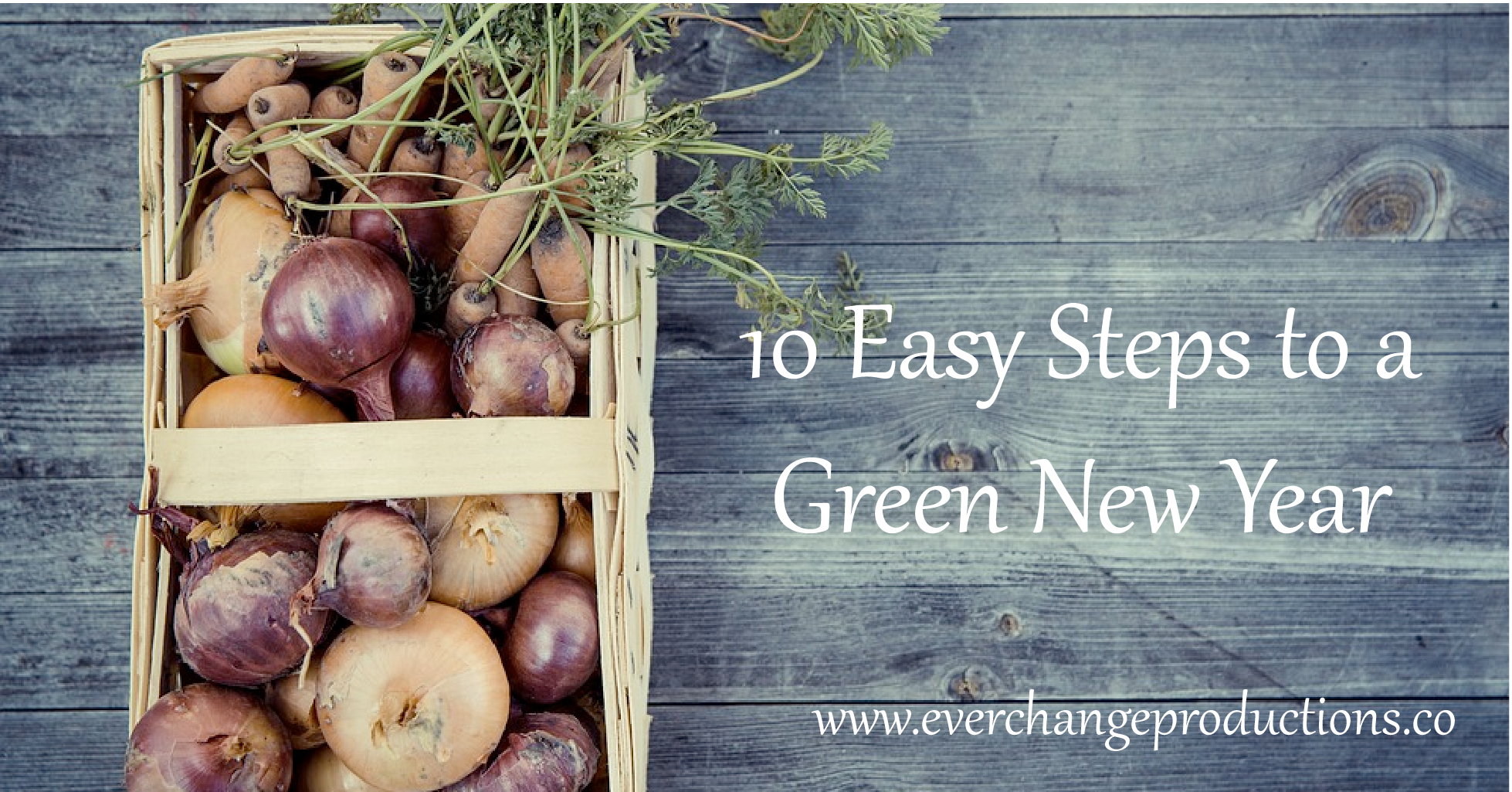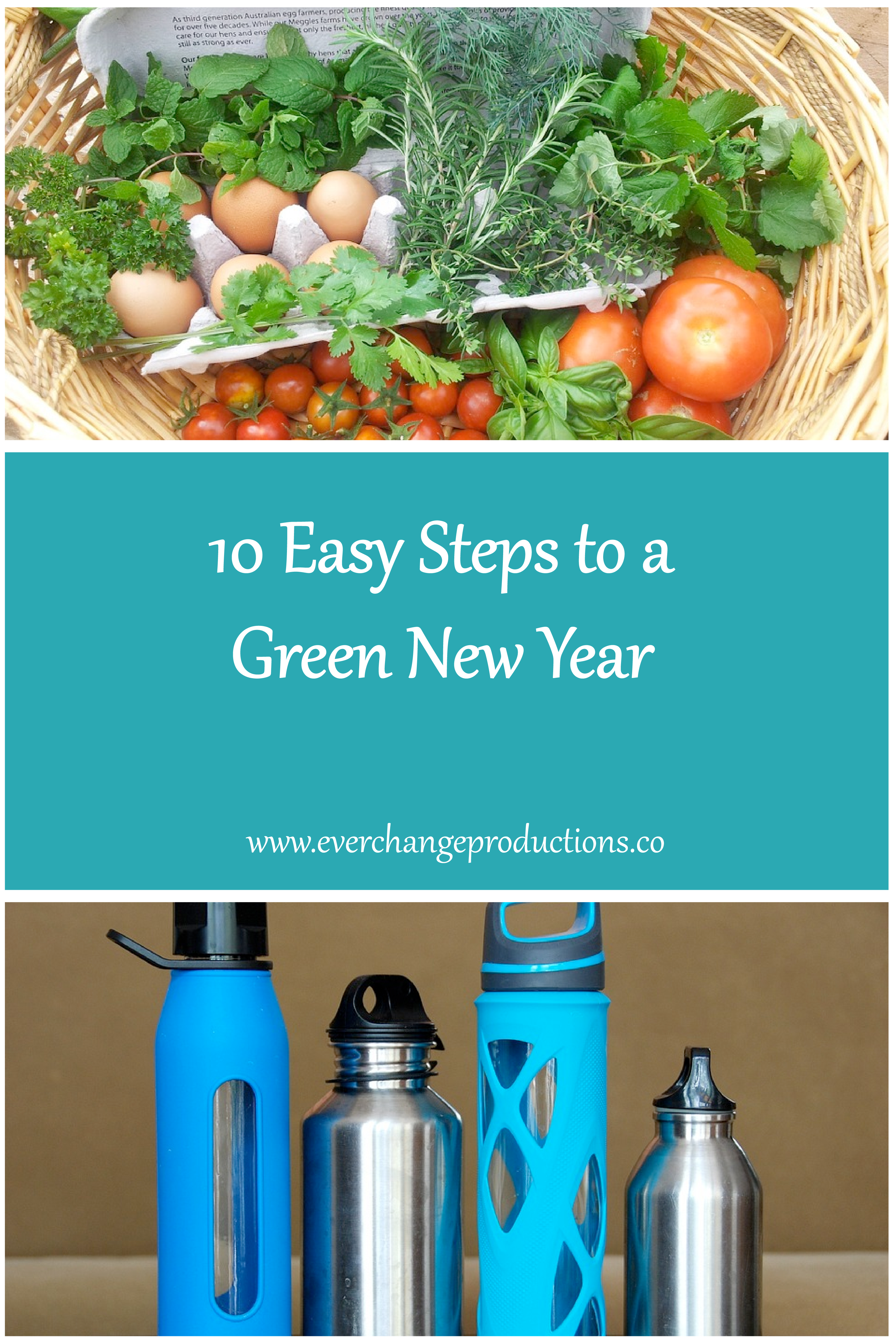How to Have a Green New Year
There are so many resolutions for a green new year. Some people choose not to mess with resolutions at all because they know how difficult it is to actually follow through. Making a resolution, especially one to be more green, really doesn’t have to be hard. The trick is to narrow down that resolution to a specific goal and make a plan. It’s also not about overwhelming yourself with resolutions, this can also make it difficult to complete the resolution. Hopefully, this post will give you some ideas for baby steps for sustainable living and once you conquer those, come back for the tips to step it up!

1. Reusable shopping bags
As Americans, we go through 100 billion plastic shopping bags every year, costing retailers about $4 billion dollars.
Although people think plastic bags are “free,” not only do stores hide their cost in higher prices at the register, but plastic bags actually cost taxpayers .17 cents per bag in pollution clean-up costs too. In the state of California alone, public agencies spend more than $25 million annually to manage plastic bag pollution. Plastic bags are difficult to recycle– only one percent of plastic bags are successfully recycled.
As far as sustainable efforts go, I’m sure this ranks high on everyone’s list for a green new year, but there is always one small problem. We can’t ever remember to bring them… This used to be a huge problem for me, but then I started shopping at Aldi’s. For those who haven’t experienced this joy, one of the many joys of Aldi’s is they charge extra for shopping bags. Generally, stores have the price of bags built into the cost of its products, but at Aldi’s they encourage you to bring your own bag or they’ll charge you extra to buy theirs. This practice helped me into the habit of bringing my own.
Tips
But for those, who don’t have an Aldi’s to remind them, having a routine that makes it easy to remember your bags is extremely important. I would recommend always having your bags put back in the car. If you have two cars that might end up with you at the store, then stock them both with your own bags. If it’s too much of a struggle to get the bags back to the car, maybe have a spot by the door to store them, so you can grab them as you go out.
Another solution is to get bags that fit easily in your purse, pocket or on your keychain, so you can have them at all times.
Step It UP
Even without plastic bags, we still bring in tons of plastic items into our homes. To take this step to the next level, you can opt for plastic-free shopping. Bring your own produce bags or bulk items sacks.
2. Take your own cup
It is estimated that 500 billion disposable cups are discarded to landfill every year. That’s one million cups a minute, every hour of every day of every year. One-hundred forty-six billion of those are dedicated to our morning coffee.
One way we can easily change this is to simply bring your own cup to get your coffee or drink your water.
Although, I’m not a coffee drinker, I’ve been drinking from a water bottle for about a year now and I love it. I’m never thirsty or searching for the nearest water fountain because I always have a water bottle at my side.
Step It UP
Once you’ve started bringing your own cup for a while, it’s time to spread the joy so others can have a green new year. Having a New Year’s party or some other gathering throughout the year? Don’t use single-serve cups. Be an example for your friends and family with reusable cups and glasses. Sure it might require an extra step, but the benefits for our Earth and future are limitless.
3. Eating at the restaurant
Take out is full of single-use items that have no other purpose than to be thrown away. Generally, restaurants buy food in bulk, so while eating out might not be better for your health or pocket book, eating in actual restaurants such as a chinese restaurant is better for the Earth when it comes to packaging. You’ll get extra bonus points for eating at restaurants that serve locally-grown produce.
Step It UP
To take this step to the next level for a green new year, cooking at home is much better for your health and pocketbook. It’s tough to go from a lifestyle of eating out all the time to cooking at home, but it definitely gives you more control over where your food comes from, it’s quality, how it’s packaged and so many other factors.
4. Recycle cardboard
Cardboard is probably one of the easiest things there is to recycle, it also is more valuable for recycling companies, however many people still don’t see the value in recycling it. Recycling centers generally don’t take greasy or dirty cardboard, so it takes little effort just to put clean cardboard into the recycling bin rather than the trash.
Step It UP
Other recyclables take a bit more effort to recycle, but in the end are totally worth it. Once you’ve seen how easy it is to recycle cardboard, take a look at your current habits and see what else could easily be recycled. It will depend on your location and the services offered, but it is a great opportunity to help your local recycling company and help the Earth at the same time with minimal effort.
5. Don’t Litter
This one really should be a no-brainer, but there is no end to the amount of damage litter does to our eco-system. There is no reason to litter, just wait until you reach the gas station or your next rest stop before throwing that cup or cigarette out the window.
Step It UP
A lot of the pollutants out there might not be caused by careless folks, but rather trash that got caught in the wind. No matter how it got there, it can wreak havoc on animals and waterways. If you see a piece of trash, pick it up. It might seem small, but those pieces will add up. Your good example might inspire others to do it too.
6. Walk to places close by
Not just a suggestion for a green new year, but walking is good for your health and cuts down wear and tear on your car. It’s up to you and your schedule, but a good goal would be to walk anywhere that takes 15 minutes or less to get to. If you have multiple stops within close proximity, you can park the car on one side and walk to the farthest location and work back toward your car.
Step It UP
Again, this is kind of up to an individual’s schedule. But try to add some extra steps to your routine and replace driving time. Plan your route to reduce driving or maybe make a commitment to walking any place within a mile.
7. Donate instead of throw away
Christmas just passed and if you’re anything like me, you have to get rid of some stuff to make room. It’s easy to just toss everything, but donating used items can be better for the Earth and your local thrift stores that probably use that money for charities.
Step It UP
This takes a bit more effort, but a minimalist life style can really be of great benefit for your every area of your life. It’s a lot less stress, requires less cleaning and effort in the long run, and is much better for the planet because you’re not buying as many new things.
8. Buy nothing one day a week
There are so many benefits to not buying things. Take one day a week to assess you budget and purchases for the week. Are these things you really need or that you have money for? Yes, there was probably a good sale, but when you stop and think that you could actually save 100 percent by not buying anything at all, it really is a no-brainer.
For me, buying nothing for a day, week or month is also about showing solidarity to the workers who make it. Especially in the electronics department, there is so many human right’s violations that went into making that. I try to live a simple life so that others might simply live. Buying less and letting go of the mentality of keeping up with the Jones’ is so freeing. I can focus on saving up for a house or investing my money, instead of living paycheck to paycheck for things I don’t really want or need.
Step It UP
Expand your buy nothing day to a week or even a month. This challenge really helps get your focus on planning ahead and only buying what you need, instead of whatever catches your attention. If you expand this practice to a greater length of time, maybe think of a buy nothing new year. Instead of getting new products made, you can purchase used products from thrift stores, Craigslist or maybe even check into a Buy Nothing New Facebook group or site. Finding a new sale is always exciting, but so it the liberation of buying things you don’t need. The hunt can go the opposite way. You can hunt at thrift stores or around your local stores and find the cheapest option.
9. Meatless one day a week
The benefits of eating less meatless are endless. A lot more of the planet’s resources are spent on meat as opposed to veggies. Going meatless once a week is a great start to a more well-rounded diet. As a rule, eating more vegetables is better for your budget, too.
Step It UP
If you decide doing one meatless day a week is doable, try to expand to do more than one day or as many days as you feel comfortable.
10. Water plants with leftover water
This may seem small, but it can make a big difference over time. Cooking water can be used in a variety of ways.
Leftover non-salted water is a great thing to use to water your plants. Let the water cool down before you disperse it on any plants. If you don’t have any plants that need watered, keep the water for making soup.
Salted or Boiling water can be used as a weed killer.
Ice cubes that fall on the ground are great for small house plants.
Step It UP
Install a water collection system. This can be a huge benefit for your water usage. Once the collection system is in place, you can free, non-chlorinated water. There are many uses for this rain water including using it for garden or agriculture, using it in place of water used for washing pets, cars, driveways and side walks, refill your pond or swimming pool, some people even use to wash their clothes and flush. For more information, check out this great link for Rainwater Harvesting 101.
I hope this list inspired you to live a green new year. Leave a comment below on your tips and tricks for a green new year!
Related Life Skills for Good Living
Looking for New Year Goals? Check out these New Year Resolutions for inspiration! Say No to Instant Gratification, Practical Ways to Save Money, Zero Waste Home Ideas, and Planting Seeds of Change.
Don’t forget to pin these for later!

This is so great, i love it! 🙂
Exciting to see ideas that are doable.